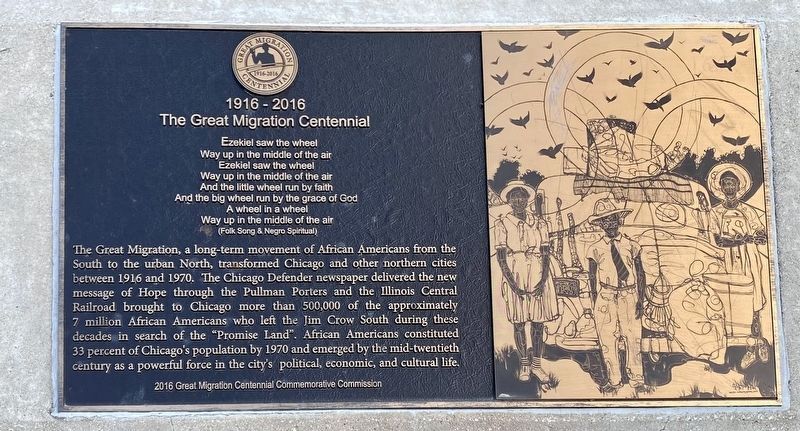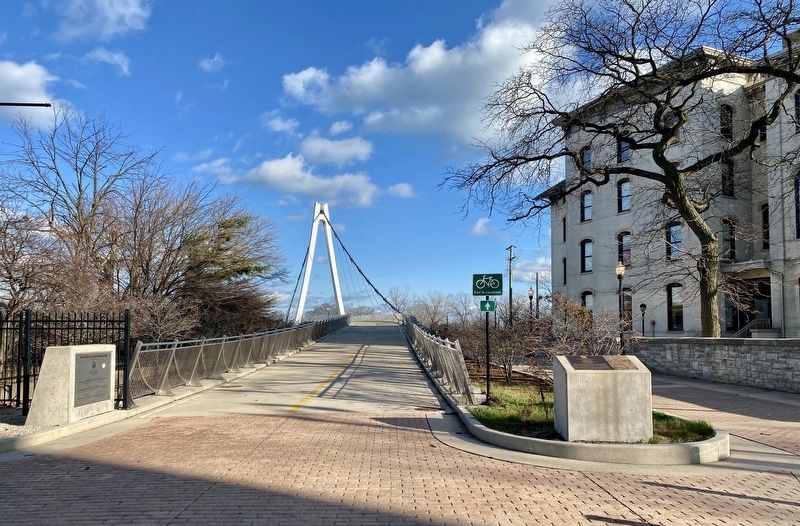Oakland (Bronzeville) in Chicago in Cook County, Illinois — The American Midwest (Great Lakes)
The Great Migration Centennial, 1916-2016
Inscription.
Ezekiel saw the wheel
Way up in the middle of the air
Ezekiel saw the wheel
Way up in the middle of the air
And the little wheel run by faith
And the big wheel run by the grace of God
A wheel in a wheel
Way up in the middle of the air
(Folk Song & Negro Spiritual)
The Great Migration, a long-term movement of African Americans from the South to the urban North, transformed Chicago and other northern cities between 1916 and 1970. The Chicago Defender newspaper delivered the new message of Hope through the Pullman Porters and the Illinois Central Railroad brought to Chicago more than 500,000 of the approximately 7 million African Americans who left the Jim Crow South during these decades in search of the "Promise Land". African Americans constituted 33 percent of Chicago's population by 1970 and emerged by the mid-twentieth century as a powerful force in the city's political, economic, and cultural life.
Erected 2017 by 2016 Great Migration Centennial Commemorative Commission.
Topics. This historical marker is listed in this topic list: African Americans. A significant historical year for this entry is 1916.
Location. 41° 49.873′ N, 87° 36.487′ W. Marker is in Chicago, Illinois, in Cook County. It is in Oakland (Bronzeville). Marker is at the intersection of East 35th Street and South Lake Park Avenue, on the right when traveling east on East 35th Street. Touch for map. Marker is at or near this postal address: 739 East 35th Street, Chicago IL 60616, United States of America. Touch for directions.
Other nearby markers. At least 8 other markers are within walking distance of this marker. Stephen Arnold Douglas (within shouting distance of this marker); Stephen A. Douglas: The Chicago Years (within shouting distance of this marker); Stephen A. Douglas: Douglas and Lincoln (within shouting distance of this marker); Stephen A. Douglas: The Douglas Tomb (within shouting distance of this marker); Stephen A. Douglas Memorial (within shouting distance of this marker); Stephen Douglas (about 600 feet away, measured in a direct line); Ida B. Wells-Barnett (approx. 0.3 miles away); Supreme Life Building (approx. 0.4 miles away). Touch for a list and map of all markers in Chicago.
Also see . . .
1. New Bronze Plaque Will Grace Bronzeville's New 35th Street Bridge (DNAInfo, February 24, 2017). (Submitted on December 16, 2021.)
2. Great Migration (Encyclopedia of Chicago).
"The Great Migration, a long-term movement of African Americans from the South to the urban North, transformed Chicago and other northern cities between 1916 and 1970. Chicago attracted slightly more than 500,000 of the approximately 7 million African Americans who left the South during these decades. Before this migration, African Americans constituted 2 percent of Chicago's population; by 1970, they were 33 percent. What had been in the nineteenth century a largely southern and rural African American culture became a culture deeply infused with urban sensibility in the twentieth century. And what had been a marginalized population in Chicago emerged by the mid-twentieth century as a powerful force in the city's political, economic, and cultural life."(Submitted on December 16, 2021.)
3. The Great Migration (1910-1970) (National Archives). The National Archives guiding page for researching the Great Migration, with links to various record types.
Excerpt: "The Great Migration is often broken into two phases, coinciding with the participation and effects of the United States in both World Wars. The First Great Migration (1910-1940) had Black southerners relocate to northern and midwestern cities including: New York, Chicago, Detroit, and Pittsburgh. When the war effort ramped up in 1917, more able bodied men were sent off to Europe to fight leaving their industrial jobs vacant. The labor supply was further strained with a decline in immigration from Europe and standing bans on peoples of color from other parts of the world. All of this afforded the opportunity for the Black population to be the labor supply in non-agricultural industries."(Submitted on December 16, 2021.)
Credits. This page was last revised on January 30, 2023. It was originally submitted on December 16, 2021, by Andrew Ruppenstein of Lamorinda, California. This page has been viewed 352 times since then and 34 times this year. Photos: 1, 2. submitted on December 16, 2021, by Andrew Ruppenstein of Lamorinda, California.

